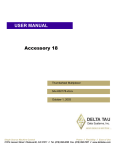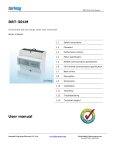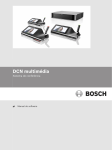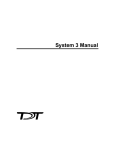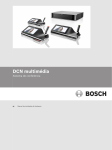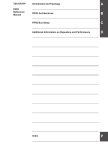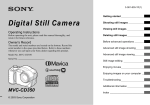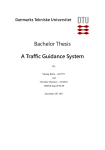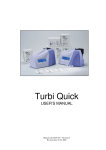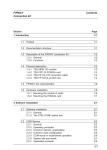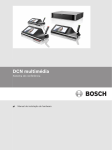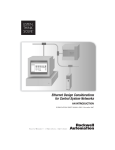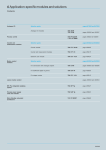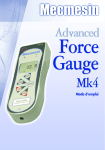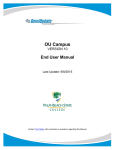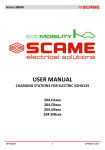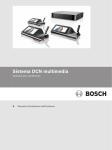Download DRPL730F_som gen - Schneider Electric
Transcript
________________________________________________________ Contents ___________________________________________________________________________ Section Page __________________________________________________________________________________________________ 1 Introduction 3 _________________________________________________________________________________________ 1.1 Documentation Presentation 3 _______________________________________________________________________________ 1.2 The Telemecanique ETHWAY Product Range 4 _______________________________________________________________________________ __________________________________________________________________________________________________ 2 ETHWAY Network Presentation 7 _________________________________________________________________________________________ 2.1 ETHWAY Layout Examples 7 _______________________________________________________________________________ 2.1-1 General 7 2.1-2 Single Network Layout 8 2.1-3 Multiple Network Layout - Redundancy 10 2.1-4 Multiple Network Layout - Concentrator 11 2.1-5 Multiple Network Layout - Bridge 12 2.2 ETHWAY Network Interface 14 _______________________________________________________________________________ 2.2-1 TSX ETH 107 Module 14 2.2-2 TSX ETH 200 Module 14 2.2-3 TSX ETH PC10 Interface Board 15 2.3 Services 16 _______________________________________________________________________________ 2.3-1 COM Word Service 16 2.3-2 UNI-TE Service 18 2.3-3 Standard Application-to-Application 19 2.3-4 Priority Communication - Telegram 20 2.4 Characteristics 21 _______________________________________________________________________________ __________________________________________________________________________________________________ 3 ETHWAY Network Operation 23 _________________________________________________________________________________________ 3.1 General 23 _______________________________________________________________________________ 3.2 Collision Detection Bus Operating Principles 24 _______________________________________________________________________________ 3.3 10Base5 Characteristics 26 _______________________________________________________________________________ 3.4 AUI Characteristics 27 _______________________________________________________________________________ ___________________________________________________________________________ 1 E ________________________________________________________ Contents ___________________________________________________________________________ Section Page __________________________________________________________________________________________________ 4 ETHWAY Design and Installation 29 _________________________________________________________________________________________ 4.1 Hardware Description 29 _______________________________________________________________________________ 4.1-1 Connection Accessories 29 4.1-2 Installation Kit 33 4.2 Designing the Network Project 35 _______________________________________________________________________________ 4.2-1 Network Calculation Rules 35 4.2-2 Network Design File 36 4.3 Preparing the Tools 38 _______________________________________________________________________________ 4.3-1 Setting the TSX ETH ACC12 Strippers 38 4.4 Fitting TSX ETH ACC3 Connectors 39 _______________________________________________________________________________ 4.4-1 Preparing the Trunk Cable 39 4.4-2 Fitting the Connectors 42 4.4-3 Fitting Ground Continuity Connectors 43 4.5 Network Installation Rules 44 _______________________________________________________________________________ 4.5-1 Grounding 44 4.5-2 Installing the Cables 45 4.5-3 Installing TSX ETH ACC2 Transceivers 46 4.5-4 Installing TSX ETH ACC6 Repeaters 48 4.6 Testing the Network 49 _______________________________________________________________________________ 4.6-1 Tests During Installation 49 4.6-2 Tests After Installation 49 4.6-3 Testing the TSX ETH ACC6 Repeater 50 4.6-4 PL7-NET Network Setup Program 51 E _________________________________________________________________________________________________________________________________________________________________________________ 5 Diagnostics 55 _________________________________________________________________________________________ 5.1 NETDIAG Program 55 _______________________________________________________________________________ 5.1-1 DIAGNOSTICS Function 55 5.1-2 PERFORMANCE Function 56 __________________________________________________________________________________________________ 6 Appendix 57 _________________________________________________________________________________________ 6.1 ETHWAY Frame Format 57 _______________________________________________________________________________ 6.2 TELWAY Network Restrictions 59 _______________________________________________________________________________ 6.3 Glossary 60 _______________________________________________________________________________ 6.4 Replacing Stripper Blades 66 _______________________________________________________________________________ 6.4-1 TSX ETH ACC12 Strippers 66 6.4-2 TSX ETH ACC16 Strippers 67 6.5 ETHWAY Network Planning Sheet 68 _______________________________________________________________________________ ___________________________________________________________________________ 2 Introduction 1 _______________________________________________________________________________________ 1.1 Documentation Presentation _______________________________________________________________________________________ This User's Manual is designed for users installing an ETHWAY network. The complete documentation set comprises: A Reference Manual (TSX DR ETH V5E) that describes: • ETHWAY network operating principles, • Network installation and test principles, • Operating, adjustment and diagnostics features, • Technical characteristics of an ETHWAY network, • A glossary of specific network terminology. Dedicated User's Manuals that apply to each type of module that can be connected to an ETHWAY network: • Device description, • Set-up and connection to the ETHWAY network, • Performance levels, • Operation with Telemecanique software and terminals, • Support for diagnostics via the network. The dedicated User's Manuals are supplied with the appropriate product. The various manuals are supplied in an A5 format binder with dividers that can be used to separate them. ETHWAY Network Reference Manual TSX ETH PC10 ETHWAY Interface Board _______________________________________________________________________________________ 3 1 Introduction _______________________________________________________________________________________ 1.2 The Telemecanique ETHWAY Product Range _______________________________________________________________________________________ The spread of distributed automation systems means increased communication requirements. More connection points are required and more data needs to be exchanged. ETHWAY is the Telemecanique X-WAY communication profile for ETHERNET. It meets ETHERNET IEEE 802.3 standards and ETHWAY devices can be connected to any existing installation and work with devices from other vendors that meet this standard. Support is provided for all of the features of the X-WAY communication layout (X-WAY addressing system, UNI-TE message system, COM word distributed data base) ensuring that ETHWAY networks are compatible with Telemecanique TELWAY, MAPWAY and FIPWAY networks). C 17 _______________________________________________________________________________________ 4 Introduction 1 _______________________________________________________________________________________ Communication layout reminders: 7 Application 6 Presentation 5 Session 4 Transport 3 Network 2 Data Link 1 Physical OSI/MMS (MAP on 802.3) MMS + ACSE Sub-layer Presentation ASN1 ETHWAY UNI-TE COM V ISO Model Session BCS Transport Class 4 V Internet ES/IS LLC IEEE 802-2 LLC IEEE 802-2 MAC IEEE 802.3 MAC IEEE 802.3 CSMA-CD IEEE 802.3 CSMA-CD IEEE 802.3 @ X-WAY _______________________________________________________________________________________ 5 1 Introduction _______________________________________________________________________________________ C 17 _______________________________________________________________________________________ 6 ETHWAY Network Presentation 2 _______________________________________________________________________________________ 2.1 ETHWAY Layout Examples _______________________________________________________________________________________ 2.1-1 General ETHWAY is specially designed for applications at: • Level 1: Coordination between PLCs, • Level 2: Local or centralized supervision and communication with production management computer systems. These applications are supported by all devices that can be connected to ETHWAY: • TSX Series 7 modular PLCs, • Machine tool and NUM robot numerical controllers, • CCX supervision systems, • IBM, DEC and Hewlett Packard computer systems, • FTX 507 terminals. The high data-rate (10 Mb/s) supported by ETHWAY means that it is a network system ideally suited to all industrial coordination and supervision applications. A Telemecanique ETHWAY network can be implemented in a number of ways: • Simple layout (single network) where a single network segment links all stations, • Structured layout (multiple network) where a number of network segments are connected together by shared PLCs (network nodes). There are two types of network node: - Bridge type where the node PLC ensures message routing from one network to another, - Multiple network station type where the node PLC collects and exchanges data separately with each network, but does not provide user-transparent data routing from one network to another. Note: Interconnection between ETHWAY networks can also be made using ETHERNET standard filtering bridges. Network layout examples illustrating the various possibilities are described in this section. _______________________________________________________________________________________ 7 2 ETHWAY Network Presentation _______________________________________________________________________________________ 2.1-2 Single Network Layout The example below shows a small scale application typical of a manufacturing process. The production cell comprises: • A conveyor system (TSX 7), • A pallet control station, • A machining center (NUM 1060), • A control and supervision station (CCX 77), • A zone controller for communication with production management systems, • An IBM PC microcomputer, • An FTX 507 terminal. FTX 507 CCX 57 Production Management Cell Control ETHERNET C Bridge 17ETHWAY Pallet Handling Machining Conveyor TSX 7 TSX 7 NUM 1060 XGS XBT UNI-TELWAY UNI-TELWAY FTX 507 XGS Machine Tool ATV 5 _______________________________________________________________________________________ 8 ETHWAY Network Presentation 2 _______________________________________________________________________________________ This application ensures close coordination between the various controllers, reducing manufacturing time and eliminating stoppages. Production quality is ensured by monitoring product and tool condition. The control position sends commands (Start/Stop) to the controllers and downloads the production programs. The control system: • Supports real-time animated man-machine interface displays, • Returns alarm signals to the management systems, • Stores all event data, simplifying troubleshooting and providing system operation statistics. The zone controller receives production orders from the management level above it. It returns the following data to the management system level: • Production result data, • Product quality data, • Machine work load levels, • etc. The user-transparence ensured by ETHWAY lets all stations within the cell communicate with each other using UNI-TE protocol. The FTX 507 terminal especially, directly connected to the ETHWAY network, lets the user access all modes and all functions that are available in local mode (access to variables, application program transfer, device handling, etc.) with practically the same response times. User-transparency therefore become total thanks to the high level of network performance. When NETDIAG software is installed, the FTX 507 terminal can also be used to de perform diagnostics on the status of the network and its stations. PLC type stations use the COM word service to exchange data separately from the application program. In this example, two stations share this service, so that each has 64 16-bit words that may require updating on each PLC cycle. For high priority messages, PLCs can use Telegram text blocks to ensure that application-to-application exchanges take place in less than 30 ms, regardless of their respective cycle times. All of these functions support exchanges that are both fast and reliable, ensuring high levels of availability and performance from the installation. _______________________________________________________________________________________ 9 2 ETHWAY Network Presentation _______________________________________________________________________________________ 2.1-3 Multiple Network Layout - Redundancy The ETHWAY network layout does not provide any redundancy in the event of a serious problem on the network. It is possible however to ensure a high level of operating security using the application program as shown below: A B C D Network N1 Network N2 All stations are connected to two separate ETHWAY networks, networks N1 and N2, via two TSX ETH 107 interface modules. Each station will therefore have to network-station addresses: N1S1 on ETHWAY network N1 and N2S2 on ETHWAY network N2. The application program for each PLC periodically checks its ability to access all stations via network N1. If all stations can be accessed, the messages destined for other stations will be sent with the N1S1 address of the target station. If a problem is encountered, the PLCs will switch to the second network by replacing the N1S1 target address of the station with its N2S2 address. Note: C This principle of operation can also be extended to COM words. Station A will then use COMi,j 17 or COMB,i,j depending on its ability to access network N1 or N2. _______________________________________________________________________________________ 10 ETHWAY Network Presentation 2 _______________________________________________________________________________________ 2.1-4 Multiple Network Layout - Concentrator In the example below, the factory comprises two identical production lines. Their length and the number of devices to connect preclude using a single ETHWAY network segment. Station 1 Station 1 Station 2 Station 2 Station 3 Station 3 Station 4 Station 4 The processes do not require exchanges between networks. Only supervision data must be made available to the higher management level. In this case, the PLC only performs to function of data concentrator for information from the two ETHWAY networks. This split layout enables intervention on one production line without affecting production on the other line while releasing the network node PLC from the workload caused by the bridge function that is no longer necessary. _______________________________________________________________________________________ 11 2 ETHWAY Network Presentation _______________________________________________________________________________________ 2.1-5 Multiple Network Layout - Bridge In this example, the factory comprises a number of separate production areas, technical service areas, sales and management departments, etc. CAD CAM Sales Orders ETHERNET Bridge ETHWAY TSX 7 TSX 7 FIPWAY CCX C FIPWAY 17 FTX 507 Cell 1 Cell 2 Cell n Large quantities of data are exchanged between the various functions. Two different networks are installed to separate the data flows and improve installation performance levels: • An ETHERNET computer network that links the various computer systems, • A number of industrial networks that are used to send production data to the management levels and vice-versa, for controlling a PLC or a numerical controller from a station located away from the shop floor (e.g. from the design office). _______________________________________________________________________________________ 12 ETHWAY Network Presentation 2 _______________________________________________________________________________________ The shop floor is divided into a number of separate production lines that are relatively independent and therefore need only exchange limited amounts of data. The communication layout will naturally follow the same logic, with an ETHWAY network for each production shop. The number of devices that can be connected (64) and the response time guaranteed by ETHWAY ensure fast updating of data between the various cells that comprise the facility. A CCX 7 supervisor directly connected to each shop network allows local production monitoring. The various shop networks are connected by branches to another ETHWAY network segment via bridge PLCs. This network also has computers connected to it. These ensure the link with the factorywide ETHERNET computer network. The FTX 507 terminal is also connected at this level and supports the same functions as those described in Sub-section 2.1-2 (Single Network Layout). This layout primarily enables: • Separation of the various data flows so that individual network segments are not needlessly overloaded, • Intervention on one network segment, if required, without affecting normal operation in the rest of the facility. The user-transparency ensured by the Telemecanique Multiple Network layout enables any device to address any other device on the network. _______________________________________________________________________________________ 13 2 ETHWAY Network Presentation _______________________________________________________________________________________ 2.2 ETHWAY Network Interfaces _______________________________________________________________________________________ 2.2-1 TSX ETH 107 Module The TSX ETH 107 module is an intelligent module for use with TSX Series 7 PLCs. It can be installed in Model 40 PLCs. 7 ETH 10 RUN DEF It supports communication functions between these PLCs and any other devices connected to the ETHWAY network. RX TX NET These devices comprise: • Model 40 PLCs, • FTX 507 terminals. For a full description of this module and its functions, refer to the "TSX ETH 107 ETHWAY Module User's Manual". 2.2-2 TSX ETH 200 Module The TSX ETH 200 module is an intelligent module for use with TSX Series 7 PLCs. It can be installed in Model 40 PLCs. C It supports communication functions between these PLCs and any other devices 17 connected to the network. 0 ETH 20 RUN DEF RX These devices comprise: • Model 40 PLCs, TX NET • FTX 507 terminals, • Any device that supports the MAP profile on IEEE 802.3 standard networks and that supports the MMS message service. For a full description of this module and its functions, refer to the "TSX ETH 200 OSI/ETERNET Module User's Manual". These two modules connect to a TSX ETH ACC2 transceiver via a TSX ETH CBxxx drop cable. _______________________________________________________________________________________ 14 2 ETHWAY Network Presentation _______________________________________________________________________________________ 2.2-3 TSX ETH PC10 Interface Board This interface board is used to connect any microcomputer with a PC AT (ISA) bus and running OS/2 1.2 or higher Operating System to an ETHWAY network. It is installed inside the microcomputer, in one of the available slots. It supports communication via the ETHWAY network for the following Telemecanique applications: • XTEL and MINI-XTEL, • NETDIAG, • XMONITOR An ETHWAY-OS/2 driver and an installation guide are provided with the interface board. These two modules connect to a TSX ETH ACC2 transceiver via a TSX ETH CBxxx drop cable. _______________________________________________________________________________________ 15 2 ETHWAY Network Presentation _______________________________________________________________________________________ 2.3 Services _______________________________________________________________________________________ 2.3-1 COM Word Service The ETHWAY network supports TSX Series 7 COM (common) word services. The complete set of COM words forms a data base that is distributed among some or all of the devices connected to the network. • The data base comprises 256 words of 16 bits. • Depending on their configuration, all network stations can access this data base. • When configuring a module it is possible to: • Inhibit its COM word activity, • Enable its COM word activity in read only, • Enable its COM word activity in read and write, • Declare the number of COM words (from 4 to 64) handled by the station. All stations on a network that exchange COM words must be configured to handle the same number of COM words. • Each TSX ETH 107 or TSX ETH 200 module has a memory field of 256 words of 16 bits that is reserved for exchanges between PLCs. This memory field is split in to sub sets of words. Depending on the number of stations that send COM words on the network, it is possible to have a maximum of: • 4 COM words per station for 64 active stations, • 8 COM words per station for 32 active stations, • 16 COM words per station for 16 active stations, • 32 COM words per station for 8 active stations, • 64 COM words per station for 4 active stations, C Stations that are declared active for the exchange of COM words must have low network addresses (e.g. for 32 stations that each handle 8 COM words, these stations 17 must be numbered from 0 to 31). _______________________________________________________________________________________ 16 ETHWAY Network Presentation 2 _______________________________________________________________________________________ Principle of operation When the COM words of a station have been updated by the CPU, they are broadcast on the network. On reception of these COM words, the network interface of any station using the COM word service updates the corresponding field and makes them available to the CPU. Use of the distributed COM word data base is recommended for the periodical sending of status variables without adding extra application program workload. To send data on brief events, application-to-application communication with a confirm is recommended as transmission is guaranteed. Station 63 max. Station 1 Station 0 OPER. OPER. Write: To COM field in the station. Read: Possible by all connected stations. Common Memory Field (256 words of 16 bits). _______________________________________________________________________________________ 17 2 ETHWAY Network Presentation _______________________________________________________________________________________ 2.3-2 UNI-TE Service The ETHWAY network supports Telemecanique’s UNI-TE industrial message system protocol. UNI-TE enables point-to-point communications using a question and answer dialog called Request/Confirm. Dialog sequencing A device that supports the UNI-TE protocol can be a: CLIENT: This device initiates communication. It asks a question (reads), sends a command (writes) or an order (Run, Stop, etc.), SERVER: This device executes the order sent by the client and sends a confirm after execution. The services supported depend on the type of device, e.g. PLC, numerical controller, programming terminal, supervision system. Depending on its function, each device can be a Client and/or a Server. The maximum message length is 128 characters. 1 Request Server Client 2 Action C 3 Confirm 17 UNI-TE is especially suited to applications such as supervision, diagnostics and control. Exchange integrity To ensure exchange integrity, the UNI-TE service uses a specific data link level acknowledgment mechanism (ACK 7). _______________________________________________________________________________________ 18 ETHWAY Network Presentation 2 _______________________________________________________________________________________ 2.3-3 Standard Application-to-Application Communication The ETHWAY network also supports communication between application programs in point-to-point mode by TXT text block or by sending a UNI-TE Unsolicited Data request. There is no confirm returned for this request. This service is especially suited to: • Sending alarm messages from a PLC to supervision station, • Exchanging data tables between two PLCs under the control of the application programs in the source and destination device. The maximum size of application-to-application messages is 256 characters. Station 0 Station 1 Station 15 Table of Wi internal or CWi constant words. _______________________________________________________________________________________ 19 2 ETHWAY Network Presentation _______________________________________________________________________________________ 2.3-4 Priority Communication - Telegram The telegram service is a special type of application-to-application message designed to transmit occasional urgent and high priority data between two PLCs on the same network segment. It is supported by all TSX Series 7 Model 40 V5 PLCs. A telegram from the PLC processor to its network interface module is processed immediately without waiting for the end of the PLC cycle. It can be received by: • Scanning the fast task, • Sending an interrupt (as soon as the message reaches the destination network module) and processing in the interrupt task. The maximum size of messages sent using this service is restricted to 16 bytes. IT task read TLG I TCY P O IT task Fast or Mast write TLG C 17 _______________________________________________________________________________________ 20 ETHWAY Network Presentation 2 _______________________________________________________________________________________ 2.4 Characteristics _______________________________________________________________________________________ Layout Type: Industrial Local Area Network with an IEEE 802.3 physical layer, Topology: Bus with active drops, Access Method: Direct access with collision detection (IEEE 802.3 standard), Transmission Mode: Base band, Coding: Manchester, Binary Data-rate: 10 Mb/s, Medium: 50 Ohm Triax. cable, Drops: Four shielded twisted pairs (AUI). Configuration Nbr. of Stations: 64 max., Nbr. of Networks: 127 max., Max. Network: Length 500 meters, Max. Distance: 1.5 kms, between 2 Stations Max. Drop: Length 50 meters. _______________________________________________________________________________________ 21 2 ETHWAY Network Presentation _______________________________________________________________________________________ C 17 _______________________________________________________________________________________ 22 ETHWAY Network Operation 3 _______________________________________________________________________________________ 3.1 General _______________________________________________________________________________________ A device on the ETHWAY network is identified by a unique address formed by the network number and the station number. Network number The network number takes one of the values given below: • 0 in single network layouts, • 1 to 127 in multiple network layouts or in single network layouts that may be connected to other networks later. Station number The station number is the physical address of the device on the network. It takes a value between 0 and 63. The physical layer and the MAC (Medium Access Control) layer in ETHWAY meet IEEE 802.3 standards, that define: • The bus access mode: by collision detection, • The physical layer: 10Base5. Its relationship to the ISO model is shown by the diagram below: ISO Model 7 Application 6 Presentation 5 Session 4 Transport 3 Network 2 Data Link 1 Physical ETHWAY Higher Layers Logical Link Control Bus Acess Control Physical Interface AUI Transceiver Trunk Cable Defined in the IEEE 802.3 standard _______________________________________________________________________________________ 23 3 ETHWAY Network Operation _______________________________________________________________________________________ 3.2 Collision Detection Bus Operating Principles _______________________________________________________________________________________ When a station wants to send data, it starts by listening to the line. If it hears no traffic, it commences sending as shown in the example below: Station 1.2 (Network 1, Station 2) wants to send, it listens to the line: Station 1.1 Station 1.2 Station 1.3 Station 1.1 Station 1.2 Station 1.3 If it hears no transmission, it sends its data. C 17 _______________________________________________________________________________________ 24 ETHWAY Network Operation 3 _______________________________________________________________________________________ If a number of stations commence sending simultaneously, they will generate collisions that will be detected by all of the stations present on the network. Stations 1.1 and 1.3 want to send. They listed to the line. Station 1.1 Station 1.2 Station 1.3 Station 1.1 Station 1.2 Station 1.3 Station 1.1 Station 1.2 Station 1.3 Hearing no traffic, they send their data at the same time. All stations detect the collision. Message Collision _______________________________________________________________________________________ 25 3 ETHWAY Network Operation _______________________________________________________________________________________ These stations will stop sending and start a contention resolution algorithm. This procedure requires waiting a random length of time before attempting to send once again. If during the new transmission attempt another collision occurs, the contention resolution algorithm is repeated with an increased waiting time. A station may make up to 16 attempts before an error condition is declared. Remark: To ensure that collisions are detected by all network stations, it is necessary to allow for the time required for message transmission. To ensure this, whenever a message is sent (regardless of its actual length), the ETHWAY interface controllers will always send a minimum of 64 bytes. ____________________________________________________________________ 3.3 10Base5 Characteristics _______________________________________________________________________________________ The IEEE 802.3 standard defines the electrical and mechanical characteristics of the trunk cable and the interface between it and the transceiver. These characteristics are summarized below: • 10Base5 means 10 Mb/s, Base band and 500 meters, C • Manchester Code, 17 = 1 logic = 0 logic, • Transmission level 2 VDC, • 50 Ohm Coax. cable, • Segment length: 500 meters max., • Type N connectors, • Between two stations there can be a maximum of three Coax. segments and two pointto-point optical links corresponding to the FOIRL (Fiber Optic Inter Repeater Link) standard. _______________________________________________________________________________________ 26 ETHWAY Network Operation 3 _______________________________________________________________________________________ 3.4 AUI Characteristics _______________________________________________________________________________________ The Attachment Unit Interface (AUI) supports station connection to the network via a drop cable. The cable, its connections and the electrical signals used are described in the IEEE 802.3 standard. Transceiver Trunk Cable AUI Station i Station j SubD 15-point connector pin arrangement (station end) The pin arrangement of the SubD 15-point connector located on the front panel of the TSX ETH 107 module corresponds to the one defined in the OSI 802.3 standard for AUI: Pin Nbr. 802.3 Standard Identification Function 1 CI-S (Control in shield) GND 2 CI-A (Control in A) COLL+ 3 DO-A (Data Out A) TX+ 4 DI-S (Data in shield) GND 5 DI-A (Data in A) RX+ 6 Vc (Voltage Common) GND 7 Option not used 8 Option not used GND COLL- 9 CI-B (Control in B) 10 DO-B (Data Out B) TX- 11 DO-S (Data Out Shield) GND 12 DI-B (Data in B) RX- 13 VP Voltage Plus 12 V 14 VS Voltage Shield GND 15 Option not used SubD body PG Protective Ground GROUND _______________________________________________________________________________________ 27 3 ETHWAY Network Operation _______________________________________________________________________________________ C 17 _______________________________________________________________________________________ 28 4 ETHWAY Design and Installation _______________________________________________________________________________________ 4.1 Hardware Description _______________________________________________________________________________________ 4.1-1 Connection Accessories Telemecanique offers a range of accessories for connecting various devices to ETHWAY networks. The full range of these accessories is shown below. For a detailed description of how to fit the connectors to the cables, refer to Sub-section 4.4: 8 6 1 7 1 4 6 8 3 4 ETH 107 RUN DEF RX TX NET 2 9 8 6 1 6 3 4 8 4 ETH 107 RUN DEF RX TX NET 2 1 TSX ETH CAxxx trunk cable, 2 TSX ETH CBxxx drop cable, 3 TSX ETH CCxxx drop cable, 4 TSX ETH ACC2 transceiver, 5 TSX ETH ACC3 N-type male connector, 6 Ground continuity connector, 7 TSX ETH ACC4 female-to-female connector adaptor, 8 TSX ETH ACC5 line terminator (isolated or not), 9 TSX ETH ACC6 repeater, 10 TSX ETH ACC10 installation kit (not shown). _______________________________________________________________________________________ 29 4 ETHWAY Design and Installation _______________________________________________________________________________________ 1 TSX ETH CAxxx trunk cable A triax cable comprising a standard 50 Ohm coax cable with a shield to ensure improved resistance to interference. This cable is used for ETHWAY network trunk cables. Both ends of a network must be fitted with a TSX ETH ACC3 connector. 2 TSX ETH CBxxx drop cable These cables are available in three different lengths (5, 10 and 20 meters) and ensure connection between a transceiver and a PLC interface module. These cables have a 90° bend at the interface end and comprise four shielded twisted pairs. Each drop cable has, at each end, a SubD 15-pin connector as defined by the IEEE 802.3 standard for AUI. 3 TSX ETH CCxxx drop cable These cables are available in three different lengths (5, 10 and 20 meters) and ensure connection between a transceiver and a TSX ETH PC10 interface board or a repeater. These cables have a 90° bend at the interface end and comprise four shielded twisted pairs. Each drop cable has, at each end, a SubD 15-pin connector as defined by the IEEE 802.3 standard for AUI. 4 TSX ETH ACC2 transceiver These are active devices (supplied by the station or repeater that they are connected to) enable the connection of device to the ETHWAY network. Each C atransceiver requires 500mA max. power. 17They comprise three main elements: 1 3 2 1 A mounting plate and ground continuity plate that the transceiver electronics are mounted on, 2 A SubD 15-point connector for connecting the stations, 3 An adapter that the TSX ETH ACC3 connectors are connected to. _______________________________________________________________________________________ 30 ETHWAY Design and Installation 4 _______________________________________________________________________________________ 5 TSX ETH ACC3 connector An N-type connector that is used to connect the transceivers to the trunk cable. 1 It comprises four parts: 1 A metal and plastic connector body, 2 A protective sleeve, 3 A shroud to crimp onto the braid, 4 A center core extension. 6 2 3 4 Ground continuity accessories These accessories are supplied with the TSX ETH ACC3 connector. They are used to connect the external shield of the trunk cable to the installation ground (through the mounting and ground continuity plate on the TSX ETH ACC2 transceiver). 7 TSX ETH ACC4 female-to-female adaptor This N-type adaptor enables connection together of two trunk cable segments. _______________________________________________________________________________________ 31 4 ETHWAY Design and Installation _______________________________________________________________________________________ 8 50 Ohm TSX ETH ACC5 terminators These terminators are used for impedance adaptation of the trunk cable. They are fitted to a TSX ETH ACC2 transceiver, at each end of a network. Two models are available: 1 1 An isolated terminator, 2 A non-isolated terminator with a threaded pin for connection to the installation ground. 9 2 TSX ETH ACC6 repeater Repeaters are used to increase the effective length of a network by amplifying the signals between two network segments. It is connected to two transceivers (one on each network) using TSX ETH CCxxx drop cables. 1620 Power Packet TCVR -0 3Com AUI/AUI r Repeate Collision Partition Technical characteristics Mains supply voltage: 220V, C Operating temperature: 0 to 40°C, Humidity level: 0 to 90% (no condensation), 17Max. power consumption (with TSX ETH ACC2 connected) less than 35W. The repeater conforms to: • IEEE 802.3 and ISO 8802/3 operational standards, • UL 1950, EN 60950 and CSA 22.2#950 safety standards, • IEC 68 environment standards. 10 TSX ETH ACC10 installation kit This tool kit is used to prepare TSX ETH CAxxx cables ready for fitting TSX ETH ACC3 connectors. It is described in Sub-section 4.1-2. Each of the elements in this tool kit is available separately. _______________________________________________________________________________________ 32 ETHWAY Design and Installation 4 _______________________________________________________________________________________ 4.1-2 Installation Kit The TSX ETH ACC10 installation kit is used to prepare the ETHWAY (TSX ETH CAxxx) trunk cable prior to fitting TSX ETH ACC3 connectors. It is supplied in box comprising four tools: 1 ETHWAY cable cutters (TSX ETH ACC11) These cable cutters are designed to cut TSX ETH CAxxx trunk cables. 2 Strippers for the ETHWAY cable outer shield (TSX ETH ACC12) This tool is designed to cut and split the outer protective insulation and the aluminum shield of the trunk cable. It comprises three main elements: 1 2 1 A replaceable blade, available separately under reference TSX ETH ACC13, 2 A button that pivots the blade through 90°, 3 3 A sliding clamp that retains the cable. This tool must first be adjusted prior to use (refer to Sub-section 4.3-1). The procedure for replacing blades is described in the Appendix. 3 Strippers for the ETHWAY cable inner shield (TSX ETH ACC16) This tool is used to prepare the trunk cable prior to fitting a TSX ETH ACC3 connector. It comprises: 3 1 A plastic body, 2 A replaceable blade cartridge, available separately under reference TSX ETH ACC17, 3 An adjustment device. 1 2 The procedure for replacing blades is described in the Appendix. _______________________________________________________________________________________ 33 4 ETHWAY Design and Installation _______________________________________________________________________________________ 5 ETHWAY connector crimping tool (TSX ETH ACC18) This tool is used to crimp the shroud and the cable center core extension onto the cable. It has two positions: 2 1 For fitting and crimping the center cable core extension, 2 For crimping the shroud supplied with the TSX ETH ACC3 connector. 1 C 17 _______________________________________________________________________________________ 34 4 ETHWAY Design and Installation _______________________________________________________________________________________ 4.2 Designing the Network Project _______________________________________________________________________________________ 4.2-1 Network Calculation Rules A network can evolve, e.g. lengthening the trunk cable, connecting additional devices, etc. Precise network calculations and a complete network design file will be invaluable when planning any future changed to an existing installation. In accordance with the recommendations of the IEEE 802.3 standard, the following calculation rules apply: • Max. network length is 500 meters, • Max. drop cable length is 50 meters, • The minimum distance between two transceivers is 2.5 meters, • To reduce the levels of signals reflected back due to manufacturing tolerances, the trunk cable segments from the same manufacturing batch must have lengths that are an uneven multiple of 23.4 meters. With L the length, L = (2n+1)*23.4 therefore: L = 23.4 or 70.2 or 117 or 163.8 or 210.6 meters, and so on. To meet this requirement, Telemecanique supplies trunk cables in 23.4, 117 and 210.6 meter lengths. • The number of TSX ETH ACC6 repeaters between two stations must not exceed two. Configuration example with five batches of trunk cable: Network 1 < 500 m Batch 1: 210 m Station Station Station Station Station Station Batch 3: 117 m Batch 2: 117 m Station Batch 4: 23.4 m Station Station Station Batch 5: 210 m Network 2 < 500 m _______________________________________________________________________________________ 35 4 ETHWAY Design and Installation _______________________________________________________________________________________ 4.2-2 Network Design File All too often, a low complexity network is installed without any effort being made to document its design. When the time comes to extend it, no reference file is available. The ETHWAY Network Planning Sheet shown below (a blank copy is provided in the Appendix) can be used to keep an ETHWAY network configuration up to date. The following information is provided for each transceiver: 1 Its location on the network, 2 2 Its number, 1 3 4 5 Nbr: 3 The length of the drop, Nbr: L= Location: 4 The name of the connected station, L= 5 The station number, 6 The distance between the transceiver and the next one, LC= 6 7 7 The total length since the first transceiver. Example: Segment 1 (11) 20 m C (12) 125 m (13) 85.6 m 10 m St 1 St 2 5m 17 Rep 1 Machining 5m Control Segment 2 (22) (23) 20 m 23.4 m St 4 Assembly 20 m (21) 23.4 m St 3 Conveyor To fill-in this sheet, start from one end of the trunk cable and make a note of all transceivers encountered and their operational characteristics. _______________________________________________________________________________________ 36 ETHWAY Design and Installation 4 _______________________________________________________________________________________ ETHWAY Network Planning Sheet Network Nbr: Nbr:11 L= 20 m m LC= L= 10 m m LC= Machining Nbr: 1 Nbr: 2 0 Segment Nbr: 1 Location: L= 125 125 m Nbr:12 Control Location: L= 85.6 210.6 m ETHWAY Network Planning Sheet Network Nbr: Segment Nbr: Nbr: 21 L= 5m 23.4 m LC= Rep 1 Nbr: Location: L= 23.4 m Nbr:22 L= 20 m m LC= L= 20 m Conveyor Nbr: 3 Nbr: 4 Location: L= 23.4 46.8 m Nbr:23 Assembly Location: L= LC= _______________________________________________________________________________________ 37 4 ETHWAY Design and Installation _______________________________________________________________________________________ 4.3 Preparing the Tools _______________________________________________________________________________________ 4.3-1 Setting the TSX ETH ACC12 Strippers Before fitting TSX ETH ACC3 connectors to the trunk cable, the user must set the ETHWAY cable strippers for correct operation. The strippers comprise four main components: 1 The blade, 2 A button that pivots the blade through 90°, 3 A sliding clamp that holds the cable while its insulation is being stripped, 4 A knob for setting the cutting depth. 1 2 4 3 There are five steps to setting the strippers prior to use: 1 Position the blade against the cable insulation and by turning the knob (identified as 4 in the figure) set the cutting depth to coincide approximately with the thickness of the grey outer insulation, 2C Place the cable in the sliding clamp and place the blade approx. 10 cm 17from the end of the cable, 3 Turn the blade approx. 10 times anti clockwise around the cable, 4 Remove the strippers, 5 The strippers are correctly set when the grey insulation is fully cut through and the inner aluminum shield is hardly scratched, i.e. when the outer insulation peals off easily when the cable is twisted slightly (the yellow shroud protecting the center core must never be damaged), 6 Yellow shroud Grey shroud If the strippers are incorrectly set, adjust the position of the knob and repeat the above operations from step 2 onwards. _______________________________________________________________________________________ 38 4 ETHWAY Design and Installation _______________________________________________________________________________________ 4.4 Fitting TSX ETH ACC3 Connectors _______________________________________________________________________________________ 4.4-1 Preparing the Trunk Cable Important TSX ETH ACC3 connectors must be fitted on the black marks on the trunk cable and placed 2.5 meters apart. They can also be fitted at the ends of a network, even where there are no black marks as long as the closest connector is more than 2.5 meters away. In order to ensure ground continuity and mount the TSX ETH ACC3 connector, the trunk cable must be prepared as shown below: m 50 m m 50 m 5 mm 11mm Grey shroud 3 mm Cut into the grey shroud Yellow shroud Braid Insulation Center core These operations are performed in the following chronological order: • Cut the trunk cable on a black mark, • Strip the outer protective insulation and the aluminum braid, • Cut into the grey outer insulation along a length of approx. 5 cm, • Strip the trunk cable inner shroud. Cutting the trunk cable Cut the cable straight across using the TSX ETH ACC11 cable cutters on a black mark (these marks are located every 2.5 meters). _______________________________________________________________________________________ 39 4 ETHWAY Design and Installation _______________________________________________________________________________________ Stripping the external insulation and the aluminum shield This operation is performed using the TSX ETH ACC12 cable strippers. Proceed as follows: • Place the TSX ETH ACC12 strippers 8 cm from the end of the cable, 8 cm • Turn the strippers clockwise around the cable approx. 10 times, taking care that they remain perpendicular to the cable to ensure a single straight cut, • Lightly fold the end of the cable to break the aluminum shield. If this operation cannot be done correctly, change the stripper settings (Sub-section 4.3-1) or replace its blade (refer to the Appendix). 8 cm Cut into the grey insulation and the aluminum shield along a length of approx. 5 cm This operation prepares the trunk cable ready for fitting the ground continuity connectors. This is also performed using the TSX ETH ACC12 strippers. Proceed as follows: •CPlace the TSX ETH ACC12 strippers approx. 5 cm from the stripped back end 17of the insulation and press down hard on the stripper to press the blade into the insulation, 5 cm • Press the button that pivots the blade through 90°, • Pull the strippers along the cable so that the grey insulation shroud and the aluminum shield are cut. If the insulation shroud and the aluminum shield cannot be cut properly, change the stripper settings (Sub-section 4.3-1) or replace its blade (refer to the Appendix). 5 cm 8 cm _______________________________________________________________________________________ 40 ETHWAY Design and Installation 4 _______________________________________________________________________________________ Stripping the inner cable insulation This operation is performed using the TSX ETH ACC16 cable strippers. Proceed as follows: • Set the adjustable slider on the strippers to position 5, • Open the stripper jaws • Place the stripper jaw against the end of the yellow shroud protecting the cable core, • Close the jaws, • Turn the strippers anti clockwise around the cable five times, • Set the adjustable slider on the strippers to position 3, • Turn the strippers anti clockwise around the cable five more times, • Set the adjustable slider on the strippers to position 1, • Turn the strippers anti clockwise around the cable ten times, • Open the stripper jaws and remove the remains of the shrouds, • Cut the center cable core so that a length of 5 mm is left exposed, • Using a knife or sharp cutting blade, cut back 2 mm off the yellow shroud, • Using a knife or sharp cutting blade, remove the aluminium shroud from the remaining 3 mm of dielectric insulation. The cable core is now ready to receive the TSX ETH ACC3 connector and the ground continuity connectors. _______________________________________________________________________________________ 41 4 ETHWAY Design and Installation _______________________________________________________________________________________ 4.4-2 Fitting the Connectors Once the cable center core is prepared, proceed as follows to fit the TSX ETH ACC3 connectors: • Slide the protective cover onto the cable (facing the right direction) then place the end shroud on the yellow cable insulation, • Using a knife or sharp cutting blade, flare the two shielding braids and the intermediate insulation, • Place the cable core extension against the end of the dielectric insulation, • Crimp on the cable core extension, using the TSX ETH ACC18 tool, small diameter position (the cable core extension must be fully home), • Slide the cable connector body up against the dielectric insulation. The end of the cable core extension must be almost up against the connector body, • Slide the shroud back over the braid and up against the connector body, •CClamp the shroud down onto the cable using the TSX ETH ACC18 tool, large diameter position, 17 • Cover the shroud and the metal part of the connector with the protective cover. _______________________________________________________________________________________ 42 ETHWAY Design and Installation 4 _______________________________________________________________________________________ 4.4-3 Fitting Ground Continuity Connectors Ground continuity is necessary to improve trunk cable resistance to electrical interference. These connectors are used to connect the outer aluminum cable shield to the system grounding network. The ground continuity connectors comprise two parts, an internal connector (small diameter) and an external one (large diameter). There are two steps to fitting them on the cable: • First, always fit the internal ground continuity connector between the yellow cable shroud and the aluminum shield (previously cut open). The ground continuity connector has small tapered holes in it to ensure better contact with the shield, • Then, fit the external ground continuity connector on the grey cable insulation, at the same level as the internal ground continuity connector. Once the ground continuity connectors are in place, they are fixed to the mounting plates behind the TSX ETH ACC2 transceivers when the cables are connected (refer to Subsection 4.5-3). The network installation rules and grounding requirements are specified in Sub-section 4.5. _______________________________________________________________________________________ 43 4 ETHWAY Design and Installation _______________________________________________________________________________________ 4.5 Network Installation Rules _______________________________________________________________________________________ 4.5-1 Grounding All of the requirements described here are taken from the TSX DG GND E, "Recommendations for PLC Installation Wiring User's Guide". The machine or chassis ground is a low impedance path between items of equipment, that is used for the purposes of equipotentiality (improvement of the immunity to noise). The purpose of this "ground" is to reduce any accidental or interference voltage that may exist between the various items of equipment, and this over a very wide frequency range. This notion takes account of the operating requirements. The protective earth ground is a low frequency, low impedance path between the machine ground and the earth ground. It is used in case of a failure between an electrical circuit and the machine ground. This notion takes account of the protection requirements. A grounding network is created by interconnecting all the metallic elements (the building structure, pipes, cable ducts, electrical and electronic equipment and their enclosures). The quality of the grounding network will be improved with a denser grid layout (a 3 m x 3 m x 3 m grid is recommended). The earth ground is the reference earth connection, consisting of a buried rod, grounding grid, or the grounding belt of the building, to which the grounding networks are connected. There must only be one earth ground per building. Grounding PLC modules The C PLC racks where modules are located must be correctly connected to the grounding network. Grounding the trunk cable 17 The trunk cable has two separate and isolated shields: • An inner shield that comprises two layers and two braids, located under the yellow insulating shroud and serving as the signal reference. This shield must be connected to the grounding network. This is done via the thread of the 50 Ohm terminator. The thickness of the wire used for this connection must be at least 2,5 mm2. To avoid any contact with ground along the trunk cable, all N-type connectors installed on the cable must be isolated, • An outer shield that comprises an aluminum foil layer between the yellow insulating shroud and the grey isulating shroud. This shield must be connected to the grounding network at each TSX ETH ACC3 connector via the ground continuity connectors provided. This connection can be made by attaching the ground continuity connectors to the transceivers or directly to the grounding network when connecting two cable segments together. Grounding the transceivers All transceivers must be directly connected to the grounding network. _______________________________________________________________________________________ 44 4 ETHWAY Design and Installation _______________________________________________________________________________________ 4.5-2 Installing the Cables Cable installation is described in Section 2 of the TSX DG GND E, "Recommendations for PLC Installation Wiring User's Guide". The main points are repeated below: Run the cables (insulated), from end to end, as close as possible to a metallic ground, such as in a metal cable duct. Ensure the electrical continuity of each section of the cable duct and connect the metal ground to the grounding network. Run signal cables in cable ducts that are distinct and separate from noise producing cables. Crossings of cable ducts must be made at 90°. A distance of at least one meter must be allowed between the trunk cable and any noise producing equipment (such as high voltage cables, high current level cables, power switches, high frequency antennas, etc.). Ensure electrical continuity at the interface between the cable duct and the equipment enclosure. The minimum curve radius is 500 mm minimum for a trunk cable and 65 mm for a drop cable. The cables are not self-supporting. The first cable attachment after a tap should be no more than one meter away from the transceiver output connector. The cable must be attached at regular intervals (approx. every 30 meters). Only install the trunk cable inside one building. _______________________________________________________________________________________ 45 4 ETHWAY Design and Installation _______________________________________________________________________________________ 4.5-3 Installing TSX ETH ACC2 Transceivers The transceivers comprise three parts: 1 A ground continuity mounting plate that the transceiver electronics are mounted on, 1 3 2 A SubD 15-point connector for connecting the stations, 3 An adapter that the TSX ETH ACC3 connectors are connected to and which comprises a test validation jumper. 2 Fitting the adaptor To mount the adaptor on the transceiver, proceed as follows: • Remove the adaptor protective cover, • Remove the two screws from the front of the device, • Correctly set the position of the jumper in the adapter to enable or disable the SQE test. This transceiver internal test must be enabled when the transceivers are connected to a station and disables when they are connected to a repeater. CThe figure below shows the two possible jumper positions, depending on the selected test: 17 SQE test disabled SQE test enabled • Plug the adapter into the device and replace the two mounting screws. _______________________________________________________________________________________ 46 4 ETHWAY Design and Installation _______________________________________________________________________________________ Reminders: TSX ETH ACC3 connectors (and therefore the transceivers) must be installed on the trunk cable and on a black mark (these can be found on the trunk cable grey outer insulation every 2.50 meters). They can also be installed at either end of a network, even if they are not located on a black mark, on condition that the nearest transceiver be at least 2.50 meters away. The transceiver support must be directly connected to the grounding network. Connecting the trunk cable to a transceiver The trunk cable connects to the N type adaptor via a TSX ETH ACC3 connector that should be screwed on finger tight. The ground continuity connectors must be directly connected to the transceiver mounting plate (see figure below). Connecting a drop cable to a transceiver The drop cable is connected to the SubD 15-point connector. The connector is locked into place by sliding the connector latch upwards (see figure opposite). _______________________________________________________________________________________ 47 4 ETHWAY Design and Installation _______________________________________________________________________________________ 4.5-4 Installing TSX ETH ACC6 Repeaters A repeater is used to interconnect two network segments and regenerate the signals so that the effective network length is increased. They are connected to each network segment via a drop cable. They comprise three main components: 1 Two SubD 15-point female connectors used to connect to the two ETHWAY networks via TSX ETH CCxxx drop cables, 3 2 Indicator LEDs, 1620 Power Packet TCVR 3 Mains power cord, -0 3Com AUI/AUI r Repeate Collision Partition 1 2 Connection example: Segment 1 (11) (12) St 1 St 2 Rep 1 C 17 (13) Machining Control (23) Segment 2 (22) St 4 St 3 Assembly (21) Conveyors Repeaters should always be installed away from any source of interference. _______________________________________________________________________________________ 48 ETHWAY Design and Installation 4 _______________________________________________________________________________________ 4.6 Testing the Network _______________________________________________________________________________________ 4.6-1 Tests During Installation During installation of the network, it is necessary to test each new segment as it is installed. To do this, start from one end of the network and fit the 50ý terminator. Then, using an ohmmeter, measure the resistance between the center contact and the connector body. The value measured must be approx. 50ý allowing for the precision of the resistance (1%) and the linear resistance of the cable (approx. 10ý/Km). If an unusual value is found, check once again that the connector of the last network segment is tight (the connector must be finger tight), or else identify the faulty connector and replace it following the instructions in Sub-section 4.4-2). Important Note: It is essential to test the network as it is installed as it will be much harder to locate a problem once the entire network is connected. If the connectors are fitted to the cable prior to installing it, it is possible to test each segment in the same way as described above, simply by placing a terminator at one of its ends and by using a female to female adaptor. Before installing a transceiver, the SQE test must be configured. This test must be enabled if the transceiver is connected to a station and disabled if it is connected to a repeater (refer to Sub-section 4.5-3). To ensure that the wiring is installed correctly, reflectometry tests can be performed where necessary. ____________________________________________________________________ 4.6-2 Tests After Installation Once the installation is complete, check that the trunk line is correctly grounded. (Reminder: The inner shield around the ETHWAY trunk cable center core must be grounded only at one point. Grounding is ensured by via a TSX ETH ACC5 terminator with a threaded pin for the grounding network). To perform this test, disconnect the connection between the terminator and ground and use an ohmmeter to check that the terminator is isolated from ground. Reconnect the ground and repeat the check using an Ohmmeter. Ensure that network impedance adaptation is correct at both ends, or else the collision rate will impede correct network operation. When the transceivers are connected to powered-up modules or repeaters, their Power LED should be lit, otherwise ensure that the connectors are correctly in place, if this is the case, replace the drop cable. _______________________________________________________________________________________ 49 4 ETHWAY Design and Installation _______________________________________________________________________________________ 4.6-3 Testing the TSX ETH ACC6 Repeater The TSX ETH ACC6 repeater comprises a number of indicator LEDs: 1 1 Partition Partition 1 24 1620 - 0 TCVR AUI Packet Power Collision AUI AUI/AUI Repeater Partition 3 1 Partition: These LEDs are lit when one partition is not part of the network traffic. In normal operation all of the LEDs should be out. If one of the Partition LEDs is lit, the corresponding segment is not operating correctly. In this case switch off the repeater and then switch it back on again. If the Partition LED remains lit, then: - Check that the Power LED on the transceiver connected to the network segment in error is lit. If not, check the cable connection and replace it if required, - Check that the SQE test for the transceiver or the segment in error is in fact disabled (refer to Sub-section 4.5-3), - If the error condition persists, recheck the trunk line as described in Sub-sections 4.6-1 and 4.6-2. 2CPacket: This LED lights when there is traffic on the network, 3 Collision: This LED blinks when a collision occurs on one of the segments (according 17to the protocol used by the IEEE 802.3 standard, intermittent collisions on the network are a normal condition), 4 Power: This LED indicates that the TSX FP ACC6 repeater is switched on. _______________________________________________________________________________________ 50 ETHWAY Design and Installation 4 _______________________________________________________________________________________ 4.6-4 PL7-NET Network Setup Program PL7-NET is used to describe, check coherence and document TSX Series 7 PLC automation system layouts. PL7-NET runs in the X-TEL V5 Software Workshop on FTX 507 or FTX 417 terminals. This software is required to describe multiple network layouts. It is recommended when setting up single network installations. PL7-NET supports: • Complete description of a multiple network layout: - Selecting the type of network (TELWAY, FIPWAY, MAPWAY, MMS on ETHERNET or ETHWAY) and entering the name and number assigned to each network (0 to 127), - Selecting the stations that form a network and assigning the station addresses, - Interconnecting the networks by selecting PLC bridge stations (the bridge ensures routing of messages between networks), - Assigning, for each bridge, the network interface modules used by the various networks (up to 4 modules allowed in each bridge PLC). This data is used by PL7-NET to generate the routing tables for each bridge in the network layout. _______________________________________________________________________________________ 51 4 ETHWAY Design and Installation _______________________________________________________________________________________ • Transferring files generated by PL7-NET to the bridge PLCs: - This data is stored in the user memory field in the bridge PLC processor, - The compare function is used to ensure coherence between the description generated by the terminal and the one stored in the bridges. C 17 _______________________________________________________________________________________ 52 ETHWAY Design and Installation 4 _______________________________________________________________________________________ • Network layout documentation: A text file can be generated once the network layout is described. This file can be printed out and defines all of the elements (and their links) as used in the network layout - Networks, - Stations, - Bridges. Network Network number Network type Number of stations connected List of stations connected Name router1 router2 Address Type 065.08 065.09 1060-TSX TSXV5 Network Network number Network type Number of stations connected List of stations connected Name router1 pack_1 Address Type 024.32 024.00 1060-TSX TSXV4 Bridge Bridge type Primary address Number of connections Connection 0 1 2 3 ethway65 065 ETHWAY 2 : : : : : mapway24 024 MAPWAY 2 : : : : Net. Address Connection Type 001.03 065.08 002.20 024.32 : : : : : MAPWAY ETHWAY 802-3 MAPWAY router1 1060-TSX 001.03 4 Rack/Module Address Status 00 07 03 05 For more information refer to the TXT DM PL7 NET V5E "PL7-NET User's Manual". _______________________________________________________________________________________ 53 4 ETHWAY Design and Installation _______________________________________________________________________________________ C 17 _______________________________________________________________________________________ 54 Diagnostics 5 _______________________________________________________________________________________ 5.1 NETDIAG Program _______________________________________________________________________________________ The NETDIAG program provides network diagnostics for ETHWAY, MAPWAY, FIPWAY and TELWAY networks. It runs in the X-TEL Software Workshop on systems directly connected to ETHWAY via a TSX ETH PC10 interface board or via the programming port of a bridge PLC. The main functions of NETDIAG are described below. ____________________________________________________________________ 5.1-1 DIAGNOSTICS Function • Complete network layout diagnostics: • List and status of each segment, • List and status of each bridge, • List of bridges crossed between two network layout segments. • Network segment diagnostics: • List of stations and error indication, • Activity of COM words assigned to each station. • Station diagnostics: • Status of PLC processor front panel LEDs, • Station status (Run/Stop, COM word configuration, etc.). • Network interface diagnostics: • Status of interface indicator LEDs, • Number of UNI-TE messages sent not acknowledged and refused, 88F00501.TIF _______________________________________________________________________________________ 55 5 Diagnostics _______________________________________________________________________________________ 5.1-2 PERFORMANCE Function This function lets the user analyze the response time of a communication path. From this information, it is possible to determine the effects of adding or removing a station from the network. A simple analysis may uncover errors in the user programs for the application (in programming or operation sequencing for example). 88F00502.TIF For more information on the NETDIAG program, refer to the TXT DM NTD V5E "NETDIAG Network Diagnostics Program User's Guide". C 17 _______________________________________________________________________________________ 56 Appendix 6 _______________________________________________________________________________________ 6.1 ETHWAY Frame Format _______________________________________________________________________________________ The general format of an ETHWAY frame is described below: Preamble 7 bytes Start Frame Delimiter 1 byte MAC Address Destination Address 6 bytes Source Address 6 bytes LLC Length 2 bytes Data for COM Word Service Data 46 to 1500 bytes CRC 32 Check 4 bytes Data for UNI-TE Service TSX Series 7 Datagram _______________________________________________________________________________________ 57 6 Appendix _______________________________________________________________________________________ Preamble The preamble is encoded in seven bits and establishes the synchronization bit and locates the first start frame delimiter bit. Destination and source address (MAC address) The frame identifies the addresses of the source and destination stations on the network. These addresses are each encoded in six bytes. For Telemecanique ETHWAY interfaces the following address is used: IEEE Standard Telemecanique Address Code 80 00 F4 Broadcast: 01 Point-to-point: 00 Network Nbr. Service 01: Series 7 message 02: COM Station Nbr. H'00' to H'3F' Data Two C types of data are sent on the network: • COM word service data, •17 UNI-TE service data (and application-to-application communication). Depending on the service used, the data in the frame will differ. The maximum data length is 256 bytes. CRC 32 check These four check bytes ensure that the exchange was performed correctly. The check code is calculated by the sender station, then sent after the data. The destination station recalculated the code and compares it with the code sent by the sender. If any incoherence is found, the message is rejected by the destination station. _______________________________________________________________________________________ 58 Appendix 6 _______________________________________________________________________________________ 6.2 TELWAY Network Restrictions _______________________________________________________________________________________ In a multiple network interface module configuration where a station that is not a bridge has both ETHWAY and TELWAY interface modules fitted (as shown in the example below), the TELWAY network number is set to 0 by default and the ETHWAY network number must be set in the terminal block of the TSX ETH 107 module. ETHWAY TELWAY TELWAY ETHWAY The PLC does not recognize the TELWAY station as network number 0 is illegal in multiple network interface module operation. Remedial action One station on the TELWAY network must be a bridge. Only a bridge station can assign a network number to a TELWAY. ETHWAY TELWAY ETHWAY TELWAY Bridge Station _______________________________________________________________________________________ 59 6 Appendix _______________________________________________________________________________________ 6.3 Glossary _______________________________________________________________________________________ A Application The user program developed on a station connected to a network. This program establishes exchanges with other stations included in a network layout. Attenuation The reduction in the amplitude of a signal sent through a cable or passive device. Attachment Unit Interface (AUI) Interface between the transceiver and the station. It is described in the IEEE 802.3 standard, which defines its cable, its connections and its electrical signals. B Baseband A transmission method where the signal is sent in its original format, without modulation. The entire bandwidth of the transmission medium is used. Bridge A device that interconnects two network segments or two networks in a transparent manner at data link layer level. Addressing continuity is ensured both before and after the bridge. The bridge is used to separate the traffic on the two segments. Broadband A transmission modulation method where the original signal modulates a carrier, in Camplitude, phase or frequency. The resulting modulated signal takes up only part of the bandwidth of the transmission medium. A number of channels can therefore use 17the same medium. Bus The layout of a signal line network. All messages are sent on the same medium and each device must recognize whether it is affected by the transaction (address recognition). This is the layout used by ETHWAY. C Carrier-Band A transmission modulation method where the original signal modulates a carrier, in amplitude, phase or frequency. The resulting modulated signal takes up the entire bandwidth of the transmission medium. Collision The state on the line when more than one station sends at the same time. _______________________________________________________________________________________ 60 6 Appendix _______________________________________________________________________________________ C COM Words A specific Telemecanique service that enables reading or writing of a database common to all stations on a network. The data is stored as a list of words shared between all stations. CSMA/CD (Carrier Sense Multiple Access with Collision Detection) Method of access to the bus. This method is defined in the IEEE 802.3 standard. D Datagram A structured data packet that transits through the network. Each data packet is a separate entity on the network. Data-rate The transmission capacity of the medium expressed in bits/second (b/s). Driver A program included in the operating system that executes transmission/reception requests via a specified peripheral. A driver is dedicated to a peripheral. It will not interpret messages read or written. Drop Cable The cable between the connector port and the station. E End Frame Delimiter (ED) The byte that indicates the end of a MAC frame. F Frame A group of contiguous bytes sent over the network containing data or control information, i.e. MAC frame, TSX Series 7 datagram. Frame Check Sequence (FCS) A group of check bytes in a MAC frame that are used to determine if a frame is correctly received. Frequency Shift Key (FSK) A type of frequency modulation where a binary element “0” becomes one frequency and a “1” another frequency. G Gateway A station that interconnects two networks of any type together. It acts as an interface at application layer level. A gateway performs address and/or protocol conversions enabling communication between devices on different networks. _______________________________________________________________________________________ 61 6 Appendix _______________________________________________________________________________________ I Industrial Local Area Network (ILAN) A Local Area Network used in industrial applications covering a well defined and limited area. ISO International Standards Organization. L Local Area Network (LAN) See Industrial Local Area Network (ILAN). Layer A layer is a set of services that perform a function as defined by the ISO in their ISO model for distributed systems. A layer provides an access interface and used the interface provided by the layer below it: • Layer 7: Application, • Layer 6: Presentation, • Layer 5: Session, • Layer 4: Transport, • Layer 3: Network, • Layer 2: Data Link, • Layer 1: Physical. Logical Link Control (LLC) access to the data link layer. For Mapway this corresponds to a service CEnables without connection but with acknowledgement (LLC 3) or without it (LLC 1). 17Manchester M Coding used to transport both logical and clock data. Manufacturing Message Service (MMS) An industrial message service. It is the application layer protocol designed for exchanging messages between devices within a manufacturing facility or workshop. Meets ISO 9506 standards. Medium Usually refers to the complete cabling system: cables, connectors, taps, etc. Medium Access Control (MAC) A set of procedures that control access to the network medium. With Mapway this comprises processing the token and sending and receiving data frames at data link layer level. _______________________________________________________________________________________ 62 Appendix 6 _______________________________________________________________________________________ M Multiple Networks A network layout where a number of network segments are interconnected by bridges. N Network A series of devices connected together via a common medium that observe the same dialog rules (protocols). Network Interface (or Module) A device that provides a station with access to the network. It optimizes exchanges and provides the highest level possible of service for the connected station (TSX Series 7 PLC, NUM controllers, FTX 517 terminals, IBM PC or compatible computers, etc.). Noise An externally caused, unwanted electrical signal present on a cable. P Phase Coherent Frequency Shift Key (Phase Coherent FSK) A type of FSK (see also FSK) where frequency changes take place when the signal goes to 0: there is no phase break. Protocol A set of rules required to ensure that various elements, often remote can establish and maintain data exchanges. R Return Loss The amount of signal reflected by an impedance discontinuity on the cable. Router This device connects at least two networks of different types at network layer level. There is no addressing continuity between the networks, before and after the router. As the addressing system is different, in practice a message is addressed to the router that ensures the required address conversion for the message to reach its destination. Routing This function is performed by a station network interface device. It determines the path to follow to ensure that a data packet will reach its destination on another segment of the network. _______________________________________________________________________________________ 63 6 Appendix _______________________________________________________________________________________ S Segment A section of trunk cable between two 50 ohm terminators not exceeding 500 meters in length. Segments are connected together through repeaters to form a network. Slot time The maximum time that a station that has finished sending must wait to detect transmission by the next station. Signal Quality Error (SQE) Test A protocol that is used between a station and a transceiver. At the end of each transmission, the transceiver must validate the signal without any collisions for a period of time, indicating to the station that the transmission was performed correctly. This test is not used when a transceiver is connected to a repeater, it must therefore not be enabled. Star A network layout where all stations are connected to the same node. Start Delimiter (SD) The byte that defines the start of a MAC frame. Station A device connected to a LAN segment. A station can exchange data with other Cstations. It has a unique address on the entire network. 17System Management Access Protocol (SMAP) This protocol controls the network functions devolved to a Mapway module. T Telemecanique Network Layout The ETHWAY, MAPWAY, TELWAY or FIPWAY network segments that are interconnected. Terminal Block Used for setting the address coding for the station (Network . Station). Terminator A component comprising a 50 ohm resistor that is connected to the transceivers at each end of a trunk cable segment. _______________________________________________________________________________________ 64 Appendix 6 _______________________________________________________________________________________ T Transceiver An active device supplied by the network enabling connection of a station to the main bus. Trunk Cable The cable that connects the transceivers together to form the network medium that transports the messages. TSX Series 7 Refers to the Telemecanique TSX Series 7 range of modular PLCs and their proprietary message system. This message system ensures transmission and reception of datagrams on the network. This includes text blocks, Uni-TE requests, programming, adjust and diagnostics requests. U Uni-TE The Telemecanique proprietary messaging service that provides a single communication interface for all Telemecanique components and those from other vendors that support Uni-TE. It comprises a list of standard requests bases on a Client/Server concept providing the following services: • Access to variables, • Control of operating modes, • Network and device management, • Up/downloading of files and programs, • Unsolicited data. V Virtual Time Operating System (VTOS) The real-time core of the ETHWAY module software. _______________________________________________________________________________________ 65 6 Appendix _______________________________________________________________________________________ 6.4 Replacing Stripper Blades _______________________________________________________________________________________ 6.4-1 TSX ETH ACC12 Strippers Replacement blades are available under reference TSX ETH ACC13. To replace the blade, proceed as follows: • Remove the screw located on the side of the tool opposite the button that pivots the blade, • Remove the cutting tool, • Insert a replacement blade into the slot in the metal blade support assembly and use it to unscrew the metal body, taking care to avoid injury from the blade, • Press the button and remove the worn blade, • Insert the replacement blade and reassemble the stripper following the steps described above in reverse order, • Adjust the strippers as described in Subsection 4.3-1. C 17 _______________________________________________________________________________________ 66 Appendix 6 _______________________________________________________________________________________ 6.4-2 TSX ETH ACC16 Strippers When the blades require replacement, turn the cartridge around (the blades are symmetrical) or, once both sides of the blades are worn, replace the entire cartridge (available under reference TSX ETH ACC17). To replace the blades, follow the procedure below: • Open the strippers, • Push the lock and remove the cartridge by pushing it with a screwdriver inserted through the hole located under the strippers (take care to avoid loosing the two red cable supports), • Turn the cartridge around (or replace it, if both side of the blades are worn), • Refit the two red cable supports (the extended side must be towards the outside of the strippers). _______________________________________________________________________________________ 67 6 Appendix ETHWAY Network Planning Sheet Network Nbr. Segment Nbr. _______________________________________________________________________________________ Nbr. Nbr. L= Location: L= LC= Nbr. Nbr. L= Location: L= LC= Nbr. Nbr. L= C Location: L= 17 LC= Nbr. Nbr. L= Location: L= LC= Update A By Date Design: Drafsman: Date: T Page B C _______________________________________________________________________________________ 68





































































